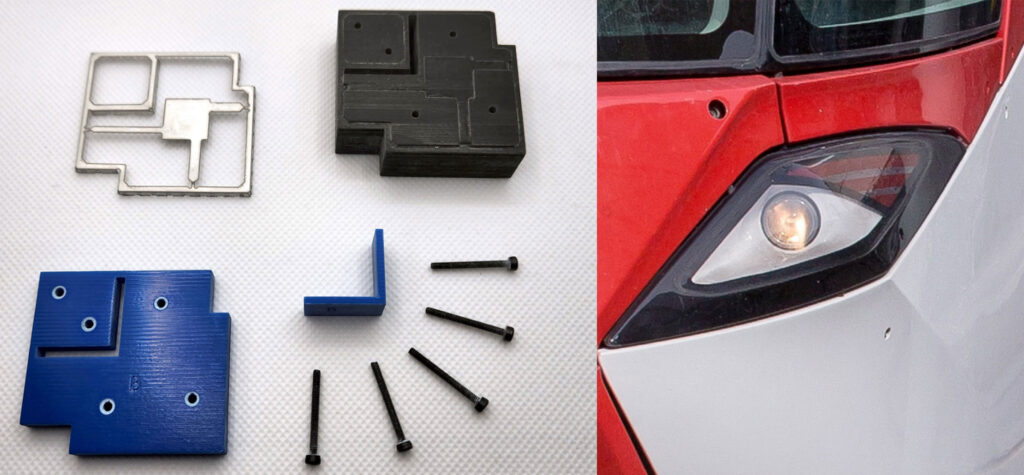Left: 3D Printed press mold for shield can frame using Stratasys PolyJet
Right: 3D printed rubber part to replace drainage plugs in train front headlights
The manufacturing landscape has undergone a profound shift with the advent of additive manufacturing. No longer relegated solely to prototyping, it has emerged as a dependable method for producing custom parts, tooling aids, jigs, fixtures, and even large end-use components. Despite the strides made in supplanting traditional manufacturing methods, there persists a demand for lower production costs per part, enhanced part quality reliability, and simplified operator training.
In response to these challenges, Stratasys embarked on a path of innovation, culminating in the revolutionary Stratasys F3300. This state-of-the-art system was meticulously crafted to address the hurdles faced by the manufacturing industry while establishing new benchmarks in FDM technology.
Traditional manufacturing has long grappled with inefficiencies, from excessive waste and prolonged lead times to costly labor and inconsistent performance. FDM, while promising, encountered its own share of obstacles:
- High Cost: FDM parts often incurred significant expenses, coupled with sluggish production speeds and varying quality, constraining their utility.
- Limited Yield: The low part yield and erratic performance hindered widespread adoption, while certification remained elusive.
- Material Costs: The financial burden of materials exacerbated the economic challenges, diminishing the appeal of FDM.
- Poor Quality: Fluctuations in part quality and reliability raised doubts about FDM’s suitability for manufacturing.
The Stratasys F3300 Advantage
The unveiling of the Stratasys F3300 marks a pivotal moment in additive manufacturing. Tailored specifically for manufacturing applications, it boasts industrial-grade features that redefine the capabilities of FDM systems:
- Industrial Design: Incorporating industrial design elements, the F3300 ensures robustness and reliability, setting a new standard in FDM technology.
- Enhanced Throughput: With increased throughput, the F3300 accelerates production cycles, delivering parts with unparalleled speed and efficiency.
- Superior Quality: Leading part quality and repeatability guarantee consistent performance, bolstered by data-driven reliability and trusted service.
- Cost Efficiency: Lower per-part costs, accelerated printing speeds, and minimized labor contribute to a more cost-effective production process.
- Innovative Features: The F3300 introduces groundbreaking innovations, including a tool changer, onboard dryers, new extruders, and an advanced control system with extensive data capabilities.
Unrivaled Performance and Versatility
The Stratasys F3300 offers unparalleled versatility, featuring a generous build volume capable of accommodating most FDM-sized parts. With four launch materials, such as ASA, PC, ULTEM 9085, and Nylon 12CF, and equipped with onboard material dryers, it ensures optimal performance across diverse applications.
A Glimpse into the Future
Backed by over 25 patents and a steadfast commitment to continuous innovation, the Stratasys F3300 heralds a new era in additive manufacturing. It not only addresses prevailing pain points but also lays the groundwork for a future where FDM emerges as the preferred solution for custom parts manufacturing, custom tooling, custom jigs, fixtures, and high-volume prototyping, revolutionizing the manufacturing landscape.

